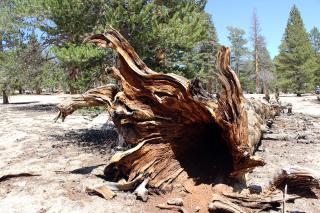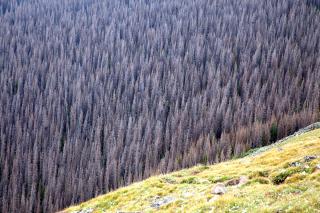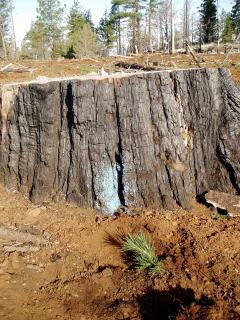Chasing Carbon
What happens when forests release more carbon than they absorb?
Kathryn Sosbe
United States Department of Agriculture
July 17, 2023

A dead tree lays on its side on the Inyo National Forest. (USDA Forest Service photo by Carol Underhill)
Forests store carbon. That is a fact.
However, what happens when disturbances such as wildfire, insect infestation, disease and natural disasters weaken the forest ecosystems we depend upon as one source to fight the effects of a changing climate?
The answer is that, today, forest carbon stocks in several Western states are declining in large part due to tree mortality caused by these disturbances. That is an important distinction, because live trees to function and grow, use carbon dioxide emitted into the atmosphere, often from human activities such as auto emissions and cement production.
Scientists know that without carbon dioxide, Earth’s natural greenhouse effect would be too weak to keep the average global surface temperature above freezing. By adding more carbon dioxide to the atmosphere, people are supercharging the natural greenhouse effect, causing global temperatures to rise.
Live trees – the carbon pump of ecosystems – actively remove carbon from the atmosphere. When trees die, they continue to store the carbon they already collected but no longer remove additional carbon from the atmosphere.
“An important nuance is that there is carbon stored in all ecosystem components, such as tree litter on the ground, soils and trees themselves,” said Grant Domke, a scientist with the Forest Service Research and Development. “Every state has carbon stored in these different pools and the amount of carbon accumulated in forests is massive, collectively storing the equivalent of more than 30 years of fossil fuel emissions in the U.S.”
Carbon is stored in five ecosystem pools: aboveground biomass (stems, stumps, branches, bark, seeds, and foliage above the soil); belowground biomass (coarse roots); dead wood (standing dead trees, snags and downed dead wood); litter (such as branches on the forest floor), and soil. Carbon is also stored in harvested wood products in use such as lumber used in decks, furniture, homes, paper products and plywood and in solid waste disposal sites such as landfills.
Domke is one of several authors of an annual report, The Greenhouse Gas Emissions and Removals from Forest Land, Woodlands, Urban Trees, and Harvested Wood Products in the United States (PDF, 1.42 MB), last published in April 2023. Over the last 30-plus years several states in the Western U.S. have incrementally emitted more carbon than they removed from the atmosphere each year. Currently, the greenhouse gas emissions report shows that Idaho, Montana, New Mexico, Utah, Arizona, Nevada, South Dakota and Wyoming are emitting more carbon into the atmosphere than they are removing. However, many other states that have long been strong net carbon sinks now show that annual gains are declining over time for many of the same reasons.
For Domke and other scientists, that is not surprising. For decades they have warned us of these scenarios and more.

The mountain pine beetle, a small insect often referred to as bark beetle, is native to the Western U.S. and a natural part of forest ecosystems around the world. An aggressive bark beetle outbreak, first detected in 1996, hit Colorado hard, leaving more than 4 million acres of dead trees standing. Although dead trees continue storing carbon they already collected while alive, the beetle outbreak left acres of trees that easily set fire. (USDA Forest Service file photo)
“Our nation’s forests are struggling under the weight of changing climate and climate-related disturbances, such as wildfires, drought and extreme weather events,” Domke said. “In a state like Colorado, there is a relatively large amount of carbon stored in forest ecosystems. But, unfortunately, due to increases in the frequency and severity of disturbances among other factors, forests capacity to sequester and store new carbon is becoming more limited and carbon stocks are declining.”
According to Colorado State University, Colorado’s 66 million acres includes nearly 24.5 million acres of the most complex forested landscape in the Intermountain West. That forestland has been the target of those very disturbances that weakens forests. Between 1996 and 2013 more than 3.4 million acres were killed due to mountain pine beetle, the most aggressive, persistent, and destructive bark beetle in the western U.S. and Canada. Between 2011 and 2020, the state faced an average 5,618 wildfires each year that burned more than 237,000 acres annually, with the Cameron Peak Fire that burned nearly four months and affected 208,913 acres, one of two of the largest fires in 2020.
Colorado is fighting back. After that devastating fire year, the state created the Colorado Strategic Wildfire Action Program “designed to quickly move $17.5 million state stimulus dollars to start on-the-groundwork on fuels reduction projects and increase Colorado’s capacity to conduct critical forest restoration and wildfire mitigation work.”
And the Forest Service is helping. In 2022, the Forest Service’s Rocky Mountain Region received $18.1 million as part of the agency’s 10-year Wildfire Crisis Strategy to treat 10,000 acres across seven national forests containing the only sources of water for the Colorado Front Range. The goal is to reduce the likelihood, intensity and size of fires in those areas. On Friday, The Forest Service announced investing another $2.04 million through the Good Neighbor Authority in projects to reduce wildfire risk and restore healthy forests.
Lara Murray is a Forest Service natural resource specialist who works on forest carbon topics.

A seedling is placed next to a tree stump as part of reforestation efforts on the Modoc National Forest. When trees are burned in a wildfire, the carbon dioxide is released back into the atmosphere. After a fire or other disturbance harms trees, the goal is to replant as soon as possible. It can take 20 years for a newly planted tree to grow and store the amount of carbon lost when older trees die. (USDA Forest Service file photo)
“When a tree dies, its carbon doesn’t vaporize overnight,” Murray said. “Carbon can remain stored in dead trees, which sometimes takes 80 years or even more to decompose. Harvested wood can continue to store carbon for decades or longer if used to make durable wood products such as construction material or furniture. So, the carbon is not immediately lost, but the Forest Service’s carbon monitoring work shows we are losing the active pumps in some regions of the country.”
Curbing this decades-long trend is possible but takes time.
“There are a variety of things that can be done. The wildfire crisis strategy is a step in the right direction with managing fire with fire that promotes regeneration and long-term ecosystem resilience,” she said. “We also need to accept that this won’t change overnight. It’s a long-term investment in maintaining and strengthening what we’ve got. And our society’s focus on climate change solutions must also point at lowering or halting emissions from outside the forest sector in other parts of the economy. We can’t rely on forests to reduce net emissions alone, and if the current trends persist, the ability of forests to fight climate change will only weaken.”
Murray and Domke agree that we all must be prepared for what scientists have predicted for a long time.
“Forests are only part of the solution. We must have realistic expectations about the capacity of current and future forests to fight climate change and provide other ecosystem goods and services,” Domke said.